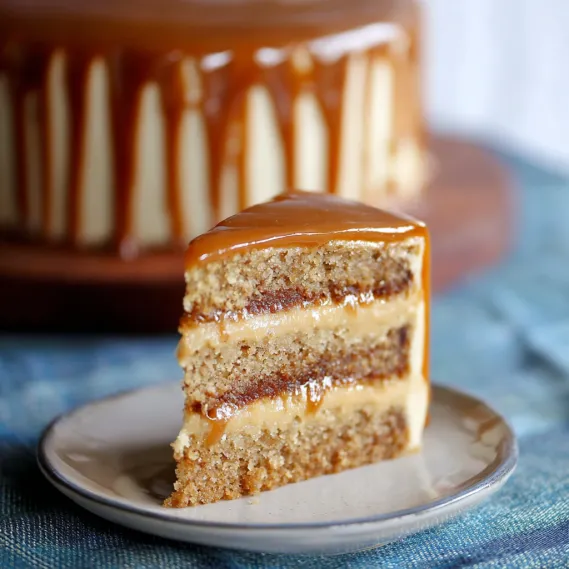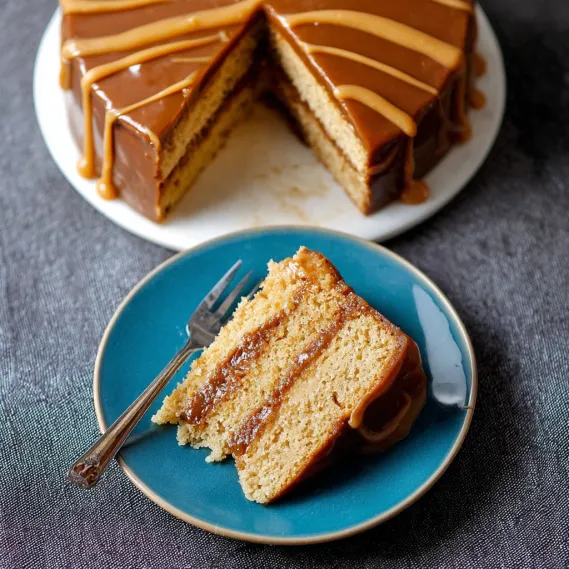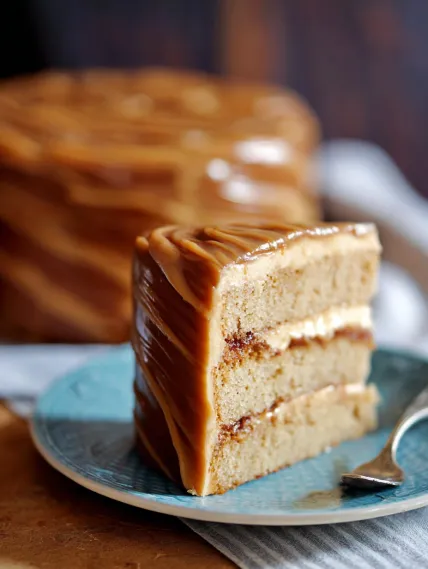 Pin
Pin
This butterscotch cake with caramel frosting transforms ordinary ingredients into an extraordinary dessert that's perfect for special occasions or whenever you need something truly indulgent. The rich butterscotch flavor in the cake paired with the silky caramel frosting creates a decadent treat that'll have everyone asking for seconds.
I first made this cake for my daughter's birthday when she requested something "not chocolate but still special." The moment I saw her eyes light up at the first bite, this became our family's celebration staple.
Ingredients
- For the cake
- All purpose flour: Provides the perfect structure without being heavy
- Granulated sugar: Brings sweetness while brown sugar adds depth and moisture
- Unsalted butter: Gives richness and allows you to control the salt content
- Large eggs: Bind everything together and provide structure
- Buttermilk: Creates tenderness and activates the baking soda
- Molasses: Is the secret ingredient that gives authentic butterscotch flavor
- Baking soda: Ensures proper rise and tender crumb
- Salt: Enhances all the flavors and balances sweetness
- Ground cinnamon: Optional but adds wonderful warmth
- For the caramel icing
- Unsalted butter: Forms the base of this rich frosting
- Brown sugar: Creates that classic caramel flavor
- Heavy cream: Makes the frosting smooth and luscious
- Vanilla extract: Adds depth and complexity
- Salt: Balances the sweetness perfectly
How To Make Butterscotch Cake with Caramel Frosting
- Prepare the oven and pan:
- Set your oven to 350°F and prepare your baking pan. I recommend using a light colored metal pan rather than glass as it conducts heat more evenly. Take time to thoroughly grease and flour the pan to ensure easy removal.
- Create the butter base:
- Beat the butter and both sugars until truly light and fluffy. This step is crucial for incorporating air into the batter, so continue beating for at least 3 minutes until the mixture changes to a lighter color and increases in volume.
- Incorporate the eggs:
- Add eggs one at a time, beating for about 30 seconds after each addition. This gradual incorporation prevents the batter from curdling and ensures a smooth texture. The batter should look glossy and well combined.
- Prepare the dry mixture:
- Whisk the dry ingredients thoroughly to ensure even distribution of the leavening agents. This prevents pockets of baking soda that could create bitter spots in your finished cake.
- Combine wet and dry ingredients:
- Add the dry mixture in three parts, alternating with the buttermilk. Begin and end with the dry ingredients, mixing just until combined after each addition. This method prevents overmixing which can lead to a tough cake.
- Add the butterscotch flavor:
- Gently fold in the molasses using a spatula rather than an electric mixer. The goal is to incorporate it evenly without deflating the air you worked to incorporate earlier. The batter will develop a beautiful amber color.
- Bake to perfection:
- Pour the batter into your prepared pan and smooth the top with a spatula. Bake in the middle rack of your oven for 30 to 35 minutes. The cake is done when it springs back lightly when touched and a toothpick inserted in the center comes out with just a few moist crumbs.
- Cool with patience:
- Allow the cake to cool in the pan for at least 10 minutes before attempting to remove it. Then transfer to a wire rack to cool completely before frosting. Rushing this step can cause the cake to break or the frosting to melt.
- Create luscious caramel frosting:
- Combine butter, brown sugar, and cream in a heavy bottomed saucepan. Use medium heat and stir constantly with a wooden spoon or heat resistant spatula. Watch for the moment when the mixture transitions from grainy to smooth and begins to bubble.
- Perfect the caramel:
- Once bubbling, reduce heat to low and simmer for exactly 2 to 3 minutes. The mixture will thicken slightly but still remain pourable. Remove from heat immediately and stir in vanilla and salt, being careful as the mixture may bubble up briefly.
- Frost with care:
- Allow the icing to cool until it thickens slightly but remains spreadable. This takes about 10 minutes. Pour and spread quickly over the cake as the icing will set rather quickly. If it becomes too thick, warm it gently to restore spreadability.
- Serve and enjoy:
- Allow the frosting to set for about 30 minutes before slicing. Use a sharp knife dipped in warm water between cuts for the cleanest slices.

The molasses is truly what makes this cake special. I discovered this by accident when I ran out of brown sugar once and substituted some molasses with white sugar. The depth of flavor was so incredible that I now always include it, even when using brown sugar.
Make Ahead and Storage
This cake actually improves with a day of rest, making it perfect for advance preparation. Store at room temperature under a cake dome for up to two days. The moisture from the molasses and brown sugar keeps it from drying out. For longer storage, refrigerate for up to a week, but bring to room temperature before serving for the best texture and flavor.
Serving Suggestions
Butterscotch cake pairs beautifully with coffee or tea for an afternoon treat. For a truly decadent dessert, serve slightly warm with a scoop of vanilla ice cream on the side, allowing the cold ice cream to contrast with the warm spices in the cake. A sprinkle of flaky sea salt on top just before serving adds a professional touch that enhances the caramel notes.

Ingredient Substitutions
If buttermilk isn't available, you can easily make your own by adding half a teaspoon of white vinegar or lemon juice to regular milk and letting it sit for 5 minutes. For a deeper flavor, dark brown sugar can replace light brown sugar in both the cake and frosting. Those avoiding dairy can use plant based butter and coconut cream instead of heavy cream for a dairy free version that still maintains the rich flavor profile.
Recipe FAQs
- → Can I substitute buttermilk in the cake batter?
Yes, you can make a quick substitute by mixing ½ cup of milk with ½ teaspoon of vinegar or lemon juice. Let it sit for 5 minutes before using.
- → How can I ensure the cake stays moist?
Avoid overbaking by checking the cake with a toothpick at the 30-minute mark. If crumbs stick to it, it's ready.
- → Can I prepare the caramel icing ahead of time?
Yes, you can prepare the frosting ahead, but reheat gently to soften before spreading over the cake.
- → What’s the best way to store leftovers?
Keep the cake covered at room temperature for up to 2 days. For longer storage, refrigerate in an airtight container.
- → What can I use instead of molasses?
If you don’t have molasses, substitute it with an equal amount of dark corn syrup or honey for a similar texture and flavor.
